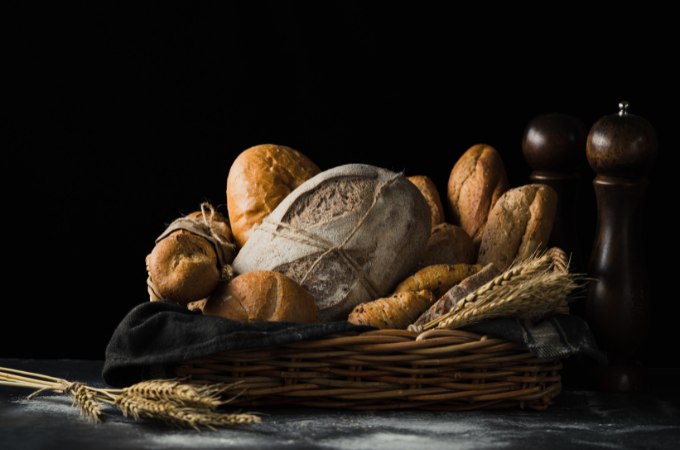
I inherited my father’s love for bread, his only rivalled by his weakness for Amala. For most of my early childhood years, my almost-insatiable mouth was stuffed with lots of it – there was always bread at home, as opposed to rice in many Nigerian homes, and it was often paired with other accompaniments, my favourite being hot chocolate beverages. These were also my formative years as a bread-eating gastronome as varieties of bread loaves – usually sardine, groundnut, shawarma, chocolate, and sliced and others whose compound nomenclature reflected what they’re complemented by or shaped as – followed my dad home from the supermarkets littered around Apapa where he worked.
Agege bread (usually bought in transit) made a few appearances in our home whenever a relative visited us in Lagos from Ibadan. To my parents’ disapproval, I was also quite fond of the ones hawked on our street in Oshodi, Lagos at that time by women typically addressed as Onibread (bread sellers). The loaves of bread were usually arranged to form a circle around a bowl of Jago or Blue Band butter in a circular wooden tray that would sit on the hawker’s head with the aid of òṣùká. These loaves, cheaper, were often in large sizes which could be cut into smaller portions depending on what one could afford.
When my family relocated from Lagos to Ibadan by the time I was age seven, Agege bread took over as the kind we consumed the most – things were rocky and it was the most accessible in the part we moved to. Consequently, the reality also differed. Bread hawking in the manner I grew up to know in Lagos wasn’t the culture – one either bought at the nearest grocery store or paid an early visit to the local bakeries before they were clothed in nylons and delivered to retailers. The loaves were in smaller sizes, so they weren’t cut to match one’s pocket.
Despite the shift in geographical and financial realities, I still desired bread. As a child, it was the perfect school breakfast, a delight to have in my lunch pack, and the best accompaniment to moin-moin, akara, or fried eggs that we usually had for breakfast on weekends at that time. As an adult, it has remained my first choice. I also have a peculiar way of eating it – digging into the loaf, tearing off a handful, squeezing it, and molding it into a chewy ball – which has made me the butt of banter many a mealtime as it amuses my family.
One might argue that bread is not so much of a special meal especially because indigenous foods are more revered amongst many Nigerians – my father, an Ibadan man, might toss bread out the window when Amala is finding its way to him. However, the love and yearning for it, especially agege bread, has made it a staple that is often present in the average Nigerian’s food fantasy – to have ‘hot’ bread paired with other complementary foods or sides like fried eggs, stew, butter, beans, moin-moin, akara, and chocolate beverages.
Nigeria, like other countries where bread is eaten today, has its history of how bread originated and became prominent – one which spans Jamaica to Nigeria. Agege bread, the most popular in the Nigerian streets, is the passage through which this history can be accessed when its origin and physical qualities – oblong shaped and unsliced – are considered. Agege bread, baked in the bakery set up in Agege, Lagos, by Alhaji Ayokunnu to cater to the city’s growing appetite for bread after the disappearance of Shackleford bread in the 1960s, is named after the bakery’s location.
Nigeria’s first contact with bread is largely attributed to the migration of Brazilians, freed African slaves who moved from Sierra Leone, and West Indians, one of whom was Amos Shackleford who set up the first bakery in Ebute Meta, Lagos, in the 1920s. During the years in which the bakery functioned, it catered largely to the bread needs of Agege people. The activities of Shackleford’s bakery were however suspended after Nigeria’s independence in 1960. In ‘Fresh Agege Bread’, a For Africa By Africa (FABA) documentary of Agege Bread’s origin by food researcher, Ozoz Sokoh, this is confirmed by Sarkin of Agege spokesman, Alhaji Kabir A. Dinar, who says that “before independence, there was a bus that used to bring bread to Agege in a van. They called it Shackleford bread. When Shackleford was nowhere to be seen, this is the beginning of bakeries springing up in most of our areas in Agege.”
Alhaji Ayokunnu’s bakery was the first of those bakeries. Using the dough bread machine introduced by Shackleford in its preparation, the Nigerian version of Hardo bread was born and christened ‘Agege.’ Agege bread then went from being the bread made in Agege bakery to sharing its name with every other bread that shares its physical qualities – oblong, thick, and unsliced baked bread. From this point, the country began to witness the rise of various kinds of breads.
Besides this, the origin of bread in Nigeria is incomplete without the reference to its Jamaican background, it is marked by migration, slavery, European colonisation – both countries were once British colonies – and the attempt at economic liberation.
The Jamaican Hardo bread whose version Shackleford introduced is said to have originated from the Chinese who migrated to the Caribbeans as British-hired indentured labourers after the 1834 abolishment of slavery which saw former slaves in the Caribbean Islands and plantations freed.
The racial prejudice Black Caribbeans continued to suffer even after centuries of slavery, together with the Chinese presence in the Caribbean, and its connection with bread is succinctly represented in V.S Naipaul’s “The Baker’s Story.” The protagonist opens the story with a description of himself as “black as Aces of Spades and ugly to match” to hint that being black in such (colonial) society meant being underprivileged and the lowest rung in its economic hierarchy. It also prepares the reader for the racial stereotype that hinders his success at first as a black bakery owner in Trinidad despite the expertise he already gained earlier at a Chinese bakery. His epiphany comes finally when he meets Percy, an old acquaintance. Fixing his puzzle with Percy’s distasteful comments about his dislike for “Black people meddling with his food,” the baker realises that “though Trinidad have every race and colour, every race have to do special things”. When Percy simply justifies his conviction saying “it don’t look nice” when Black people meddle with his food in public places, it becomes clearer to the protagonist that Black people are especially ill-fated to be confined to the lowest rung in terms of job opportunities and income. This he challenges by employing Macnab, a “half black and half Chinee” boy to be the face of his bakery which begins to thrive tremendously as a result.
With the history of bread in the Caribbean Island and Nigeria, the economic symbolism of bread is significant, especially considering that its different origins in Jamaica and Nigeria are migrants in search of greener pastures. It is the same in the short story which mirrors the economic realities of Black Caribbeans which the baker fights by making his “dough from dough.” Shackleford made his dough from dough. Sokoh’s documentary also revealed that he hired indigenes thereby providing them with a source of livelihood.
The Bible’s reference to bread in “The Lord’s Prayer” symbolises the comfort of this world (that money can bring). My household is also not exempt from this economic symbolism of bread. Through our initial move from Lagos to Ibadan, the family’s financial stability could be measured by how frequently we bought bread and the kind of bread we bought. Now, as a semi-financially independent adult, buying bread for the home, most importantly, the kind/quality of bread my mother would eat – she’s (or her tastes are) as bougie as a modest gen x(‘s) can be – brings me a moment of pride and satisfaction rooted in my relative financial stability.
Bread (Agege or not) is a part of many Nigerians’ lives – popular in big cities, and yearned for in remote communities. The current high cost of producing this principal character in my food choices and many street meals, which is engendered by Nigeria’s economic downturn, has begun to tell on its pricing and sizing. Without doubt, the kind and quantity (that is deemed enough) of bread a Nigerian can afford currently might be telling of their position on the socioeconomic ladder.










Babatunde Kehinde ayokunnu November 18, 2023 22:52
Thanks for this that was my father Alh babatunde fatal Ayokunnu